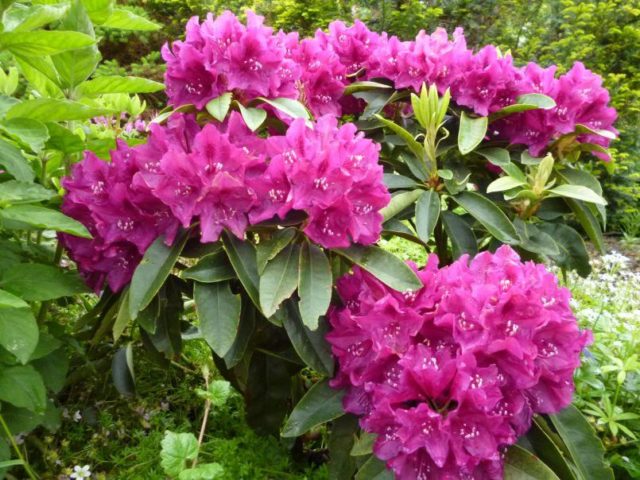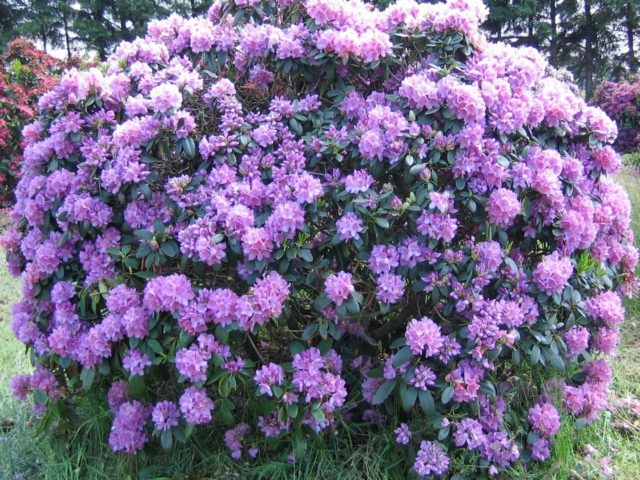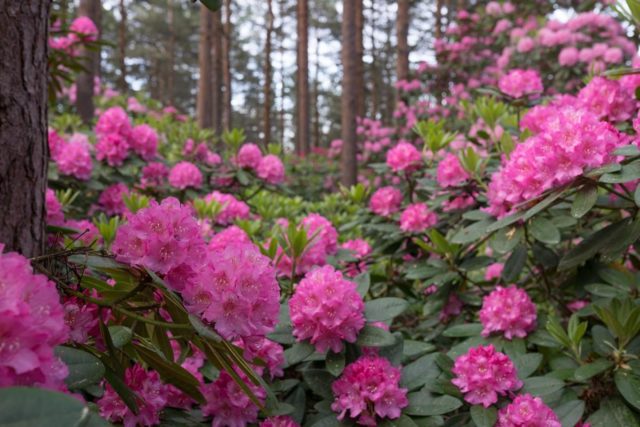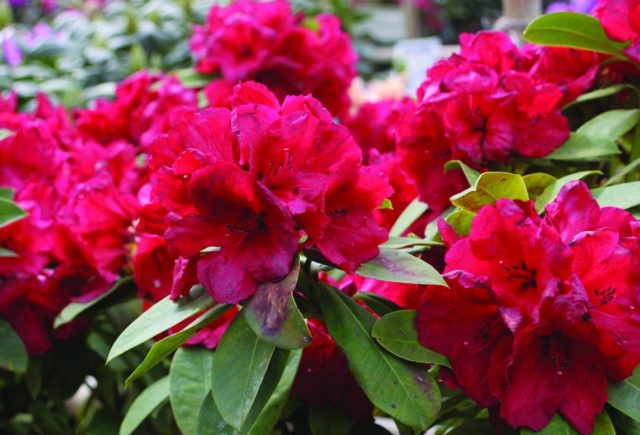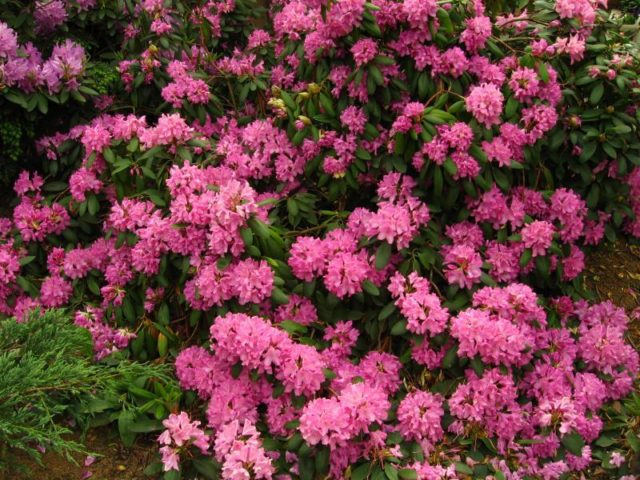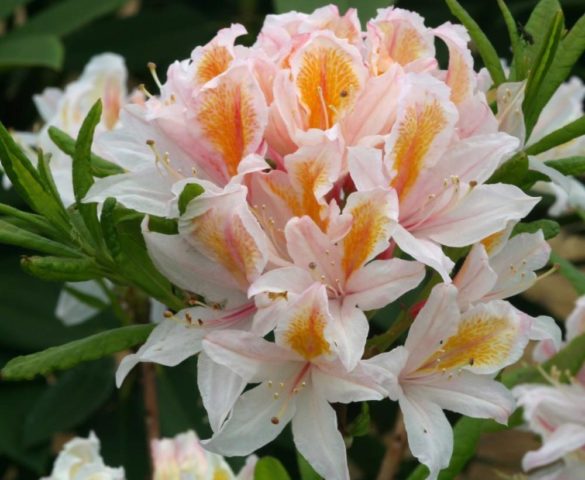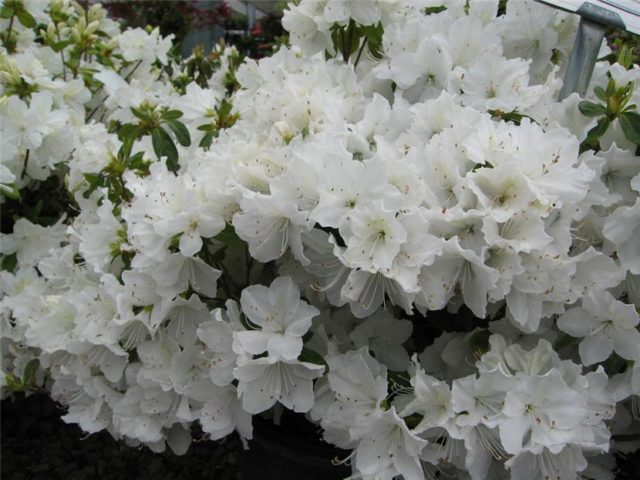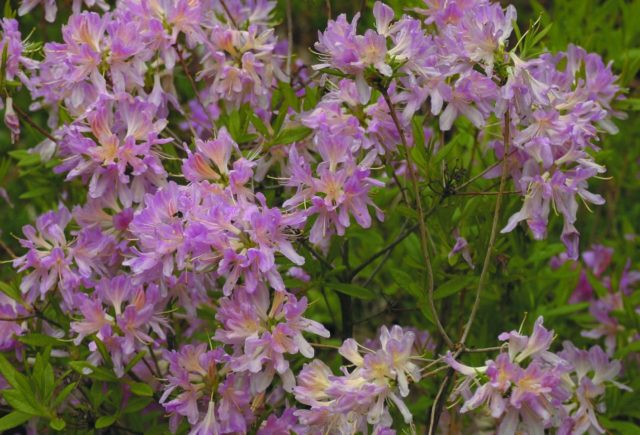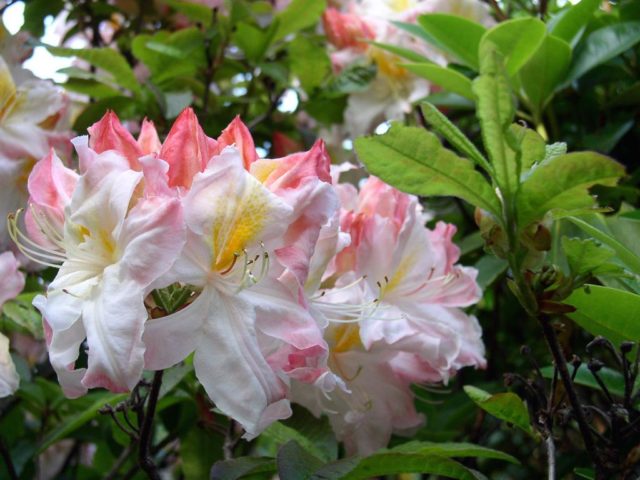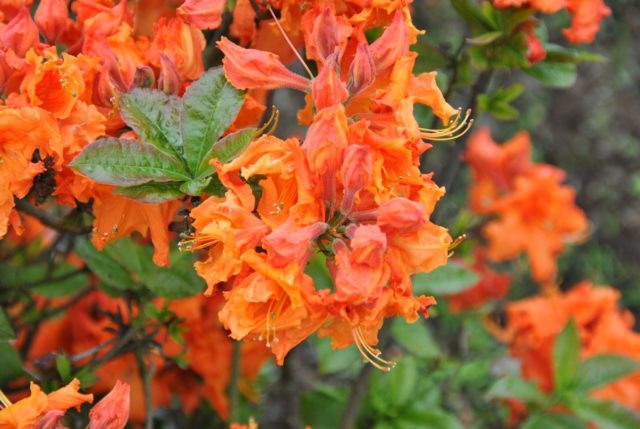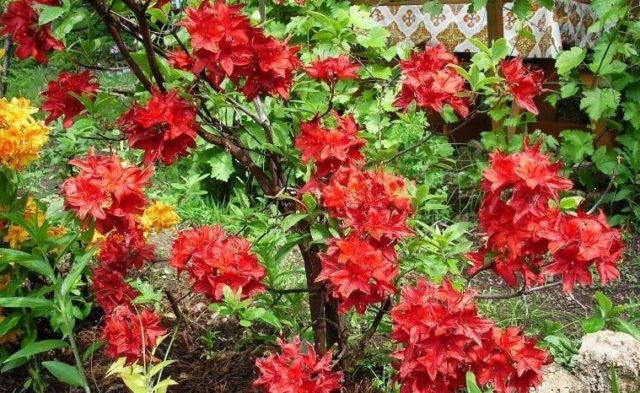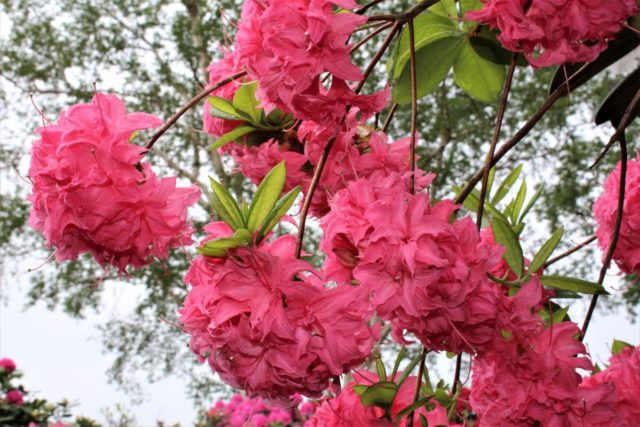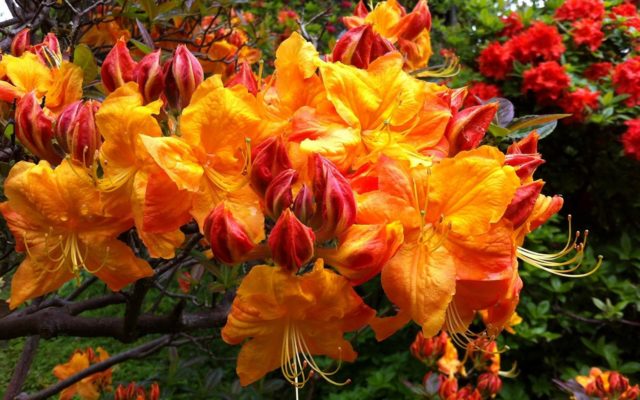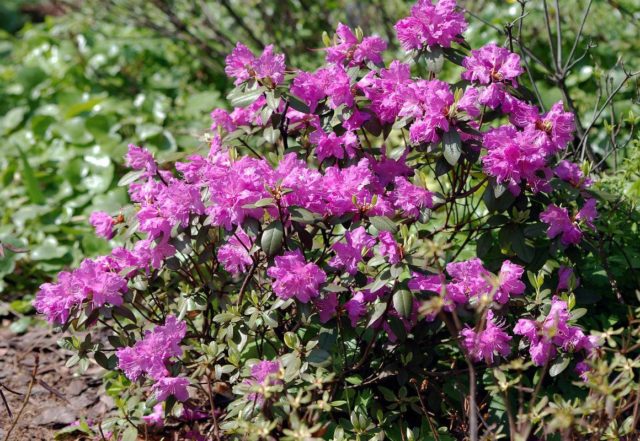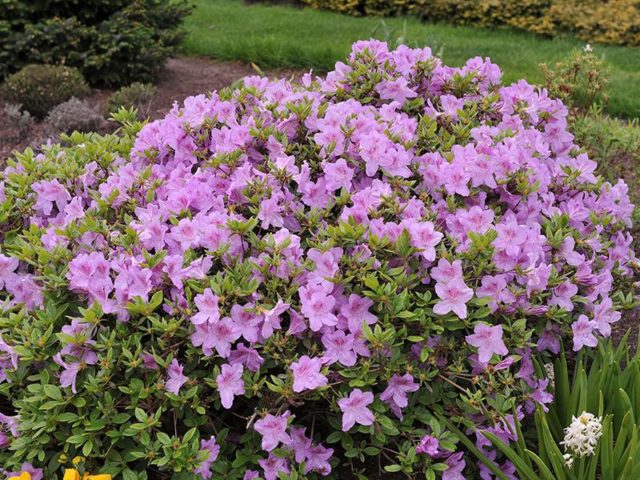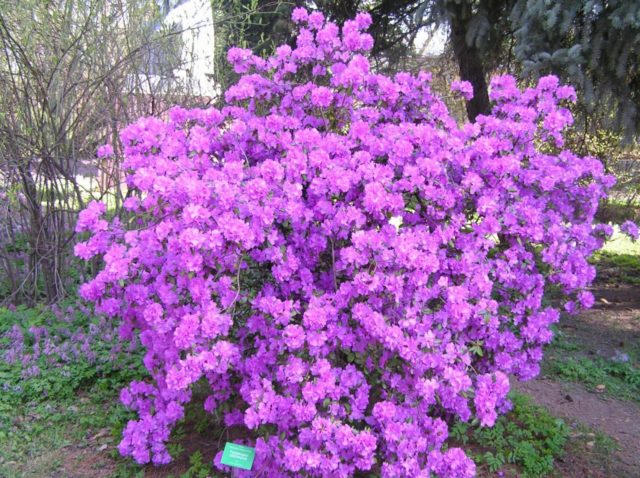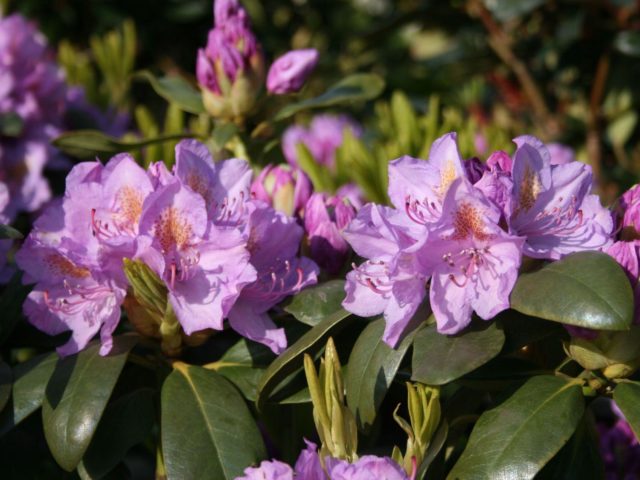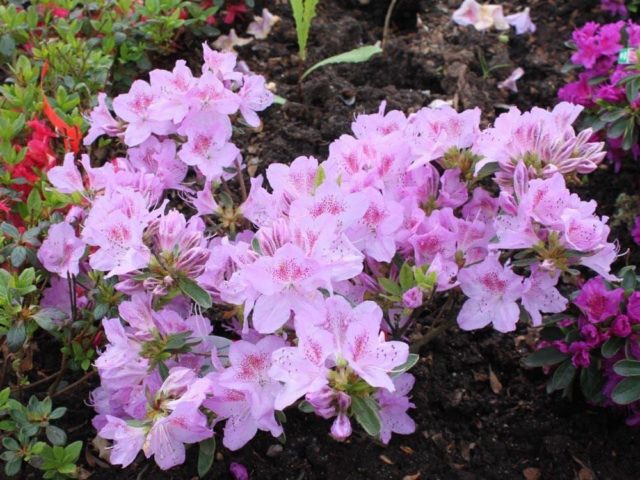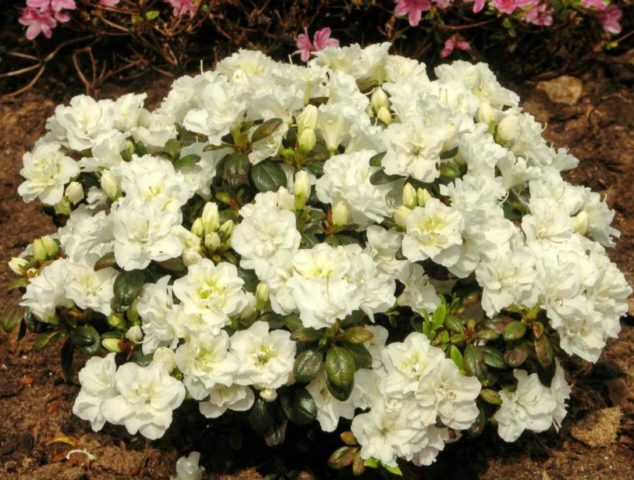Content
Rhododendron is a shrub that is grown throughout the Northern Hemisphere. It is appreciated for its decorative properties and abundant flowering. In the middle lane, the plant is only gaining popularity. The main problem with growing rhododendrons is cold winters. Therefore, for planting, hybrids are chosen that can tolerate even harsh winters. The following are frost-resistant varieties of rhododendrons with photos and descriptions.
Evergreen frost-resistant varieties of rhododendrons
Evergreen rhododendrons do not drop leaves in the fall. They become dehydrated and curl up even in frost-resistant varieties. The stronger the frosts, the more pronounced this effect. When spring comes, the leaves unfold. For the winter, even frost-resistant rhododendrons are covered with non-woven fabric.
Alfred
A frost-resistant hybrid was obtained in 1900 by the German scientist T. Seidel. Plant height up to 1.2 m, crown diameter - 1.5 m. The plant bush is compact enough, with brown bark and elongated leaves. Flowering of the Alfred variety begins in June. The flowers are purple, with a yellowish spot, up to 6 cm in size. They grow in inflorescences of 15 pieces.
Alfred rhododendron variety blooms annually and abundantly. The buds bloom within 20 days. The shrub grows 5 cm annually. The plant is light-loving and frost-resistant, tolerates light partial shade. The variety prefers slightly acidic soil, rich in humus. The hybrid is propagated by cuttings or layering. The seeds have a low germination rate - less than 10%.
Grandiflorum
Frost-resistant rhododendron Grandiflorum was eaten in England at the beginning of the 19th century. The shrub grows up to 2 m in height. The crown of the rhododendron reaches 1.5 - 2 m in girth. Its shoots are dark gray, the leaves are elliptical, leathery, 8 cm long. The crown of the culture is spreading. The flowers are lilac, 6 - 7 cm in size. They are odorless and bloom in compact inflorescences of 15 pieces. Flowering takes place in early June.
The rhododendron variety Grandiflora blooms in June. Due to the large inflorescences, the hybrid is also called large-flowered. The shrub has a decorative appearance during the flowering period. The Grandiflora variety grows rapidly, its size increases by 10 cm per year. The plant prefers sunny places, but it is able to develop in the shade. The hybrid is frost-resistant, tolerates winter frosts down to -32 ° C.
Winter-hardy rhododendron Grandiflora in the photo:
Helsinki University
Rhododendron Helsinki University is a frost-resistant hybrid bred in Finland. The plant reaches a height of 1.7 m, its crown diameter is up to 1.5 m. It develops well in partial shade from buildings and larger trees. Its leaves are dark green, with a shiny surface, in the shape of an ellipse, 15 cm long.
The flowering of the Helsinki variety begins in June, with even young shrubs producing buds. The flowers of the culture are up to 8 cm in size, funnel-shaped, light pink, with red blotches in the upper part. The petals are wavy at the edges. Flowers are collected in 12 - 20 pieces in large inflorescences.
Pekka
A frost-resistant Finnish variety obtained by specialists from the University of Helsington. The rhododendron of this variety grows intensively, reaching a height of 2 m in 10 years. After that, its development does not stop. The largest shrubs can be up to 3 m. Crohn culture is round and very dense.
The leaves are dark green, bare. Due to its good foliage, the Pekka variety is used for landscaping parks and squares. Flowering occurs in mid-June and lasts for 2 - 3 weeks. Inflorescences are light pink, with brown specks on the inside.
Rhododendron variety Pekka is frost-resistant, tolerates winter frosts down to -34 ° С. The plant prefers partial shade, the ideal places for its cultivation are sparse pine forests. For the winter, a burlap shelter is built over the bush to retain moisture in the soil.
Hague
The evergreen rhododendron of the Hague variety is another representative of the Finnish series. The shrub is frost-resistant, grows up to 2 m in height and 1.4 m in width. Its crown is of the correct rounded or pyramidal shape, the shoots are gray, the leaves are dark green, simple.
The Hague is prized for its abundant flowering, even after a harsh winter. Flowers of its pink color, collected in inflorescences of 20 pieces. There are red spots on their inside. Rhododendron buds bloom in mid-June, in cold weather - at a later date.
The flowering period is up to 3 weeks. The variety is frost-resistant, and does not freeze at temperatures down to -36 ° C. It develops well in partial shade.
Peter Tigerstedt
The Peter Tigerstedt variety is named after a professor at the University of Helsington. The scientist was engaged in the cultivation of rhododendrons and the breeding of frost-resistant hybrids. The shrub reaches a height and width of 1.5 m. The density of the crown depends on the illumination: in the shade it becomes more rarefied. Leaves are glabrous, elongated, dark green.
The buds of the Tigerstedt variety are cream-colored. The inflorescences consist of 15 - 20 flowers. The petals are of a white flower, on the top there is a dark purple spot. Flowers - funnel-shaped, 7 cm in diameter. Rhododendron blooms in late May and early June. The variety is frost-resistant, not afraid of cold weather down to -36 ° C.
Hachmans Feuerstein
The frost-resistant variety Hachmans Feuerstein is a wide bush up to 1.2 m high. Rhododendron grows in breadth, the bush reaches 1.4 m in girth. The leaves are large, rich in color, with a glossy surface.
The variety is prized for its abundant flowering and decorative appearance. The flowers are dark red and consist of 5 petals. They are collected in large spherical inflorescences and grow at the top of the shoots. Even young shrubs have buds. Flowering occurs in early summer.
Rhododendron variety Hahmans Feuerstein is frost-resistant. Without shelter, the shrub does not freeze at a temperature of -26 ° C. With soil mulching and additional insulation, it can withstand more severe winters.
Roseum Elegance
An ancient frost-resistant hybrid, bred in 1851 in England. The variety became widespread in cold regions in the northeast of America. The shrub is vigorous, reaches a height of 2 - 3 m. It grows annually by 15 cm. The crown is wide, rounded, up to 4 m in girth. The shrub does not freeze at temperatures down to -32 ° C.
Rhododendron leaves are leathery, oval, rich green color. The buds bloom in June. Inflorescences are compact, consist of 12 - 20 flowers. The petals are pink, with a reddish spot, wavy at the edges. The flowers are funnel-shaped, up to 6 cm in size. The stamens are lilac.
Deciduous winter-hardy varieties of rhododendrons
In deciduous rhododendrons, the leaves fall off for the winter. In autumn, they become yellow or orange in color. The most frost-resistant hybrids were obtained in the USA and European countries.Most of these varieties tolerate cold temperatures down to -32 ° C. Deciduous hybrids survive the winter under cover of dry leaves and peat.
Irena Koster
Frost-resistant rhododendron Irena Koster obtained in Holland. Shrub up to 2.5 m high. Its average annual growth is 8 cm. The crown is round, wide, up to 5.5 m in diameter. The leaves are oblong, in autumn they become burgundy or yellow.
The flowers of the plant are pink in color, with a yellowish spot, 6 cm in size, have a strong aroma. They are collected in compact inflorescences of 6 - 12 pcs. Blooming of buds occurs in the last days of May. The culture is used for group plantings next to evergreen hybrids. A winter-hardy variety of rhododendron for the Moscow region and the middle zone is resistant to frost down to -24 ° C.
Oxidol
A frost-resistant hybrid bred in 1947 by English breeders. Shrub up to 2.5 m high. The crown reaches 3 m in girth. Shoots are green with a reddish undertone. The branches are erect, growing rapidly. Frost resistance is -27 ° С. The variety is considered promising for growing in the middle lane.
The leaves of Rhododendron Oxidol are green, in autumn they become burgundy and yellowish. The plant blooms at the end of May. The last buds bloom at the end of June, snow-white, wavy at the edges, with a barely noticeable yellow spot of flowers. The size of each of them is 6 - 9 cm. They form a rounded inflorescence
Orchid Lights
Rhododendron Orchid Lights belongs to the group of frost-resistant varieties. The plants were obtained from the University of Minnesota. Work on them began in 1930. In addition to this hybrid, American specialists have developed other frost-resistant varieties: Rosie Lights, Golden Lights, Candy Lights, etc.
The Ochid Lights variety is distinguished by its compact size. Its height is up to 0.9 m, its width does not exceed 1.2 m. The crown of the plant is rounded. Its leaves are pointed, flat, green-yellow in color. Flowers 4.5 cm in size, tubular, with a strong aroma, bloom in mid-May. Their color is light purple with a yellow spot.
In favorable conditions, rhododendron grows up to 40 years. He rarely gets sick, because he is immune to fungal diseases. The hybrid can withstand frosts down to -37 ° C. Generative buds are not damaged at -42 ° C.
Silfides
Rhododendron Silfides is one of the English varieties bred at the end of the 19th century. Hybrids were derived from Japanese and American varieties. The Silfides variety is the most frost-resistant representative of the group.
The average height of the plant is 1.2 m, the maximum is 2 m. Its crown is rounded; when blooming, the leaves gradually turn greenish from a dark red color. Frost resistance of the Silfides variety reaches -32 ° C. The culture develops well in partial shade and in sunny areas.
Flowers bloom in inflorescences of 8 - 14 pieces. Their flowering period falls in May and June. The funnel-shaped sepals are white with a pinkish tinge. In the lower part of the petals there is a yellow, rounded inflorescence. The variety has no aroma.
Gibraltar
The Gibraltar rhododendron is a sprawling bush with a dense crown. It reaches 2 m in height and width. The growth rate is average. Young leaves of brown color gradually turn dark green. In autumn, they take on a crimson and orange color. The variety is suitable for growing in the middle lane and the North-West region.
The bush produces numerous bell-shaped flowers. The petals are curved, orange. Flowers grow in groups of 5 - 10 pieces. Each of them reaches 8 cm in girth. Flowering occurs in mid-May and early June.
Nabucco
Rhododendron Nabucco is a deciduous frost-resistant variety. The flowering shrub has a decorative appearance. Its size reaches 2 m. The rhododendron of this variety is spreading, not like a small tree.Its leaves are collected in 5 pieces at the ends of the shoots. The shape of the leaf plate is ovoid, tapering around the petiole.
The flowers of the plant are bright red, open, and have a faint aroma. Abundant flowering begins in late May and lasts until mid-June. In autumn, the foliage becomes yellow-red. The hybrid is frost-resistant, can withstand cold temperatures down to -29 ° C.
The Nabucco variety looks spectacular in single plantings and in combination with other hybrids. The plant reproduces well by seeds. They are harvested in the fall and germinated at home.
Homebush
Homebush Rhododendron is a medium-flowering deciduous variety. It is a shrub with numerous straight shoots. Its growth rate is average, the plant reaches 2 m in height, has a powerful bush that requires regular pruning.
Abundant flowering shrub, begins in May or June. The petals are pink, double, pointed in shape. Inflorescences are spherical, 6 - 8 cm in size. Young leaves from bronze in summer become rich green. In autumn, they change color to crimson, then to orange.
The hybrid is frost-resistant, can withstand cold temperatures down to -30 ° C. It grows without problems in the Northwest. In a harsh region, the flowering of the bush is annual.
Klondike
The Klondike rhododendron variety was obtained in Germany in 1991. The hybrid got its name in honor of the Klondike region - the center of the gold rush in North America. Rhododendron grows rapidly and strikes with abundant flowering.
Flowers in the form of large bells have a pleasant aroma. Unblown buds are red with orange vertical stripes. The blossoming flowers have a golden yellow color.
The shrub grows well in shady and lighted places. Its petals do not fade in the sun. The variety is frost-resistant, does not freeze at temperatures down to -30 ° C.
Semi-leafy frost-resistant varieties of rhododendrons
Semi-leafed rhododendrons shed their leaves under unfavorable conditions. When the air temperature rises, the shrubs quickly regenerate their green mass. For the winter, frost-resistant varieties are covered with dry leaves and spruce branches. A frame is placed on top and a non-woven material is attached to it.
Rhododendron Ledebour
The winter-hardy Ledebour rhododendron grows naturally in the coniferous forests of Altai and Mongolia. Shrub with thin, upward-directed shoots, up to 1.5 m high with dark gray bark, leathery leaves up to 3 cm long. In winter, foliage curls and opens up during thaws. At the beginning of the development of new shoots, it falls off.
Ledebour's rhododendron blooms in May. The buds bloom on it within 14 days. Re-flowering occurs in autumn. The bush has a decorative look. Flowers of its pink-purple color, up to 5 cm in size. The plant is frost-resistant, little susceptible to diseases and pests. Propagated by seeds, dividing the bush, cuttings.
Pukhan rhododendron
The frost-resistant Pukhan rhododendron is native to Japan and Korea. The shrub forms thickets on mountain slopes or in pine forests. The height of the plant does not exceed 1 m. Its bark is gray, the leaves are dark green, oblong. Flowers 5 cm in size, very fragrant, with pale purple petals with brown blotches bloom in 2-3 pieces in inflorescences.
The shrub develops slowly. Its annual growth is 2 cm. In one place the plant lives up to 50 years, preferring neutral moist soils. The frost resistance of the culture is high. For the winter, the Puhkhan rhododendron has enough light shelter from dry leaves and spruce branches.
Rhododendron sihotinsky
Sikhotin rhododendron is frost-resistant and decorative. In nature, it grows in the Far East - singly or in groups. Prefers coniferous undergrowth, rocks, rocky slopes. The height of the shrub is from 0.3 to 3 m.Its shoots are reddish-brown, the leaves are leathery with a pleasant resinous aroma.
During the flowering period, the Sikhotinsky rhododendron is almost completely covered with large flowers. They are 4 - 6 cm in size, funnel-shaped, pinkish to deep purple in color. The buds bloom within 2 weeks. Secondary flowering is observed in warm autumn. The plant is frost-resistant and unpretentious. It develops in acidic soil.
Rhododendron blunt
A frost-resistant variety, found naturally in the mountains of Japan. Plant with a height of 0.5 to 1.5 m with a wide and thickened crown. The leaves of the bush are green, elliptical. Blooming in April-May, pink flowers, 3-4 cm in size, have a funnel shape with a weak aroma. The flowering period is up to 30 days.
Dull rhododendron grows slowly. For a year, its size increases by 3 cm. The shrub prefers illuminated places, loose, slightly acidic soils, its life span is up to 50 years. The plant can withstand frosts down to -25 ° C, for the winter its branches are bent to the ground and covered with dry leaves.
Wykes Scarlet
Vykes Scarlet rhododendron belongs to the Japanese azaleas. The variety was bred in Holland. The shrub grows up to 1.5 m, its crown is sparse, up to 2 m in girth, the leaves are pubescent, elliptical, up to 7 cm long.
Shrub flowers in the form of a wide funnel, dark carmine color, up to 5 cm in size. Flowering begins in the last decade of May and lasts until the middle of the next month. It is ideal for heather orchards and rock gardens. Rhododendron Vykes Scarlet is planted in places protected from the wind. The variety looks great in group plantings.
Ledicaness
Ledikaness rhododendron is a representative of semi-deciduous shrubs. Shoots are located straight. The crown of the azalea is wide and dense. It blooms in the last decade of May - early July. The flowers are in the form of a wide bell, with a color of light lilac, with purple spots in the upper part. This shade is considered rare for deciduous rhododendrons.
An adult plant reaches a height of 80 cm, and a width of 130 cm. It grows well in the middle lane and in the North-West. The winter hardiness of the bush is increased, it can withstand a drop in temperature to -27 ° C. For the winter, they organize a shelter from dry leaves and peat.
Schneeperl
Rhododendron of the Schneeperl variety is a representative of semi-leafy azaleas, which reach a height of no more than 0.5 m. Their crown is rounded, up to 0.55 m in size. Terry snow-white flowers bloom from late May to mid-June. The flowering of the bush is very abundant, the plant is covered with buds.
The Schneeperl variety is frost-resistant and is not afraid of cold weather down to -25 ° C. Semi-shade areas are chosen for planting. Under the bright sun, the leaves burn out, and the bush develops slowly. For abundant flowering, rhododendron needs moist soil, rich in humus.
Conclusion
The frost-resistant varieties of rhododendrons with the photos discussed above are very diverse. Evergreen or deciduous hybrids are chosen for planting in cold climates. They are resistant to temperature extremes and tolerate severe winters well.
